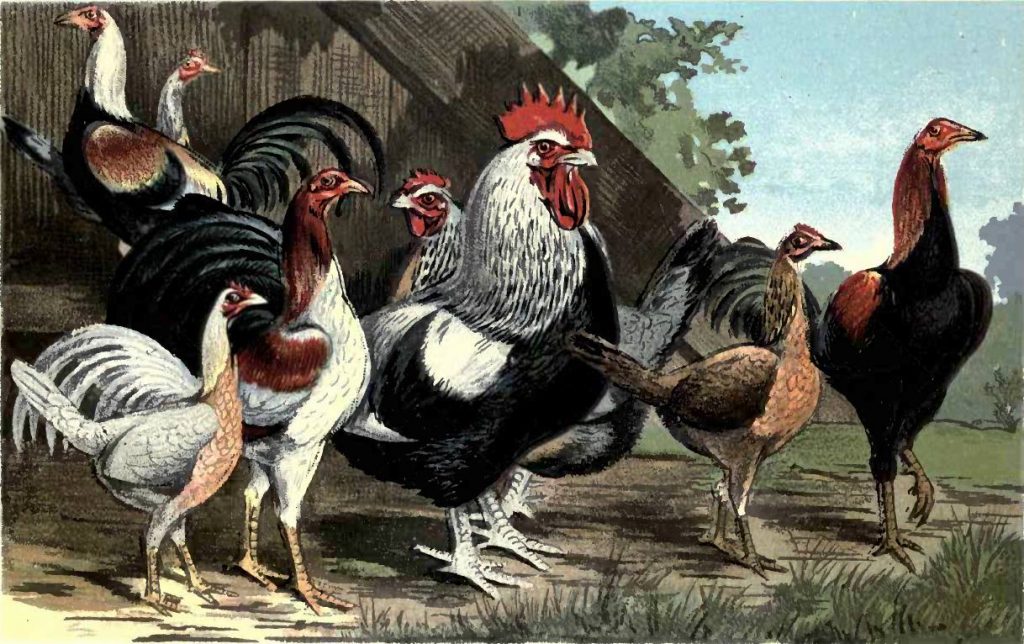Duckwing Game, Pile Game, Grey Dorkings & Black-Red Game from The Practical Poultry Keeper by Lewis Wright 1867. Colour Illustrations by Ludlow from the 1899 Revised Edition.
Dorkings
THIS is a pre-eminently English breed of fowls, and is, as it always will be, a general favourite, especially with lady fanciers. The general predilection of the fair sex for Dorkings may be easily accounted for, not only by the great beauty of all the varieties, but even more, perhaps, by their unrivalled qualities as table birds a point in which ladies may be easily supposed to feel a peculiar interest.
The varieties of Dorkings usually recognised are the Grey or Coloured, Silver-grey, and White. We believe the White to be the original breed, from which the Coloured varieties were produced by crossing with the old Sussex or some other large coloured fowl.
That such was the case is almost proved by the fact that fifty years ago nothing was more uncertain than the appearance of the fifth toe in Coloured chickens, even of the best strains, and that rosecombs were also common. Such uncertainty in any important point is always an indication of mixed blood ; and that it was so in this case is shown by the result of long and careful breeding, which has now rendered the fifth toe permanent, and finally established the variety.
In or about the year 1858, Mr. John Douglas, then in charge of the Duke of Newcastle’s aviaries at Clumber, crossed the English breed with a cock from India. This bird was not a Cochin or Malay, as often alleged, but of distinctly Dorking type in everything but the fifth toe, and was probably the result of some Dorking cross in India on some Asiatic bird unknown.
He was very large, and the progeny was on an average at least two pounds heavier than the old English stock, and much more uniform in plumage, the hens being very dark, verging in parts upon a brownish-black, with robin breasts, and the cocks more black-breasted. Few had not the fifth toe, and all soon came true in that respect ; and this cross has now influenced all the exhibition stock, greatly increasing the size and hardiness of the fowls, without losing any important point, except, perhaps, in one exception : that is, that with the habitual dark colour has crept in a dark or sooty foot, and even leg.
In the Silver-grey Dorking, however, colour is imperative. This variety was a chance offshoot from the preceding, improved by careful breeding, and a cross with Lord Hill’s breed of Silver Duckwing Game, the colour of which was aimed at.
Game Fowls
THIS is the celebrated race of fowls, bred from time immemorial for the purposes of the cock-pit, and in which courage was so developed by the severe selection of combat that a breed was finally obtained which did not know how to yield.
Happily cock-fighting in England is now a thing of the past, except amongst a very few who carry on their cruel sport upon the sly ; but it is very interesting to notice that this cessation of the old purpose for which it was bred has worked gradually a very great change in the shape and formation of the Game fowl.
The modern exhibition race is very different in many respects from the old fighting race. The old fowl was moderately short on the leg, not very long in the neck, not short in feather, but with a full hackle, and with a rather large fanned and spreading tail, carried tolerably high. All these points have been changed.
Duckwings
Duckwings are very handsome birds. The cock’s face is bright red, head white, hackle verging more to a strawcolour lower down ; saddle hackles straw or yellowish ; back, wing bow, and shoulder coverts rich gold or light orange ; bright steel-blue bar across the wing ; breast and under parts black. The hen’s head is silvery grey; hackle silver grey striped with black; breast salmon, shading off to grey on thighs; rest of plumage generally, a silvery grey, evenly pencilled over with darker grey, total effect being a beautiful silvery or frosted kind of grey. The legs of both sexes are willow ; eyes, bright red.
There has, in fact, always been a true breed, called “Silver” Duckwings, which were never crossed.
In this pretty variety the cock’s hackles and light parts are clear white, free from straw, and the breast a purer or brighter black; the hen resembles the usual Duckwing, except for rather a purer or more silvery colour. There is no doubt the ordinary Duckwings arose from crossing this breed with the Black-reds; and as the Duckwings are bred more and more without Black-red aid, the tendency will be, as it has been, to return to the pristine purity of colour, or rather freedom from colour, and predominance of pure black, white, and grey shades.
Pile Game
Pile Game may briefly be described as in general Black-reds, with white substituted for black, but the red colours as before. It is well known that black and white are convertible colours, so that many black Cochins were originally bred from whites, and white Minorcas have been bred from blacks.


